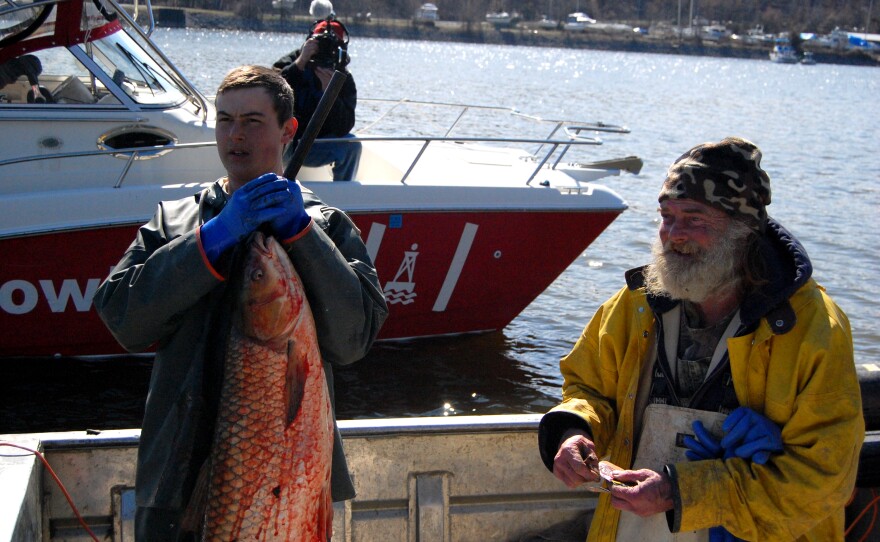The invasive Asian carp are multiplying rapidly throughout the Mississippi and Ohio rivers and their tributaries. They're a scourge for native fish, tourists and commercial fishermen. Whitney Jones went to the first Asian carp fishing tournament to find out why Asian carp are such a destructive nuisance.
At six in the morning around 15 commercial fishermen began to show up to the “Carp Madness” tournament with their boats, nets and heavy coats to brave the near freezing temperatures on Lake Barkley. Ronnie Hopkins of Ledbetter doesn’t usually fish for carp. In fact, most commercial fishermen don’t because there’s not much of an American market for them.
Hopkins, who has been fishing for almost 60 years, looks like a scruffier version of the Gorton’s fisherman with his graying beard and bright yellow rain coat. A sweet smelling cigarillo hangs out of his mouth as he pulls carp out of the nets while his fellow fishermen drag the nets into the boat.
“I can’t read and write my mother’s name," he said. "I’m illiterate. What I know didn’t come out of books, it’s things I’ve learned from dealing with them.”
In the Kentucky lakes there are two species of Asian carp, bighead and silver. Hopkins says he first saw the bigheads, which can weigh more than 100 pounds, after a 1983 flood. Then ten years later the silver carp showed up. Fast forward 20 more years to today and the carp are beginning to take over and eat the plankton many of the sport fish rely on to survive.
"We still have the other species of fish," Hopkins said. "Now the number is decreasing because the Asian carp, because they’re killing their spawn of the other fish and they’re eating up the food supply of other plankton eaters, like the paddlefish, starving them to death.”
At the tournament, Hopkins works with two men and his grandson Byron. After the four drop hundreds of feet of net into the lake, they rev their boat to startle the fish. The carp are sensitive to vibrations in the water, which cause some of the skittish fish to swim into the nets while the silver carp jump into the air.
The jumping fish can be dangerous for recreational boaters and water skiers, causing black eyes, concussions and even broken bones when the fish leap without warning.
Kentucky Fish and Wildlife Resources Fisheries Director Ron Brooks says a large part of the growing Asian carp problem is that they spawn, or reproduce, three or four times a year, while other native fish spawn just once annually.
“These things start moving up streams and they go through spawning motions," Brooks said. "They have over 1 million eggs per fish. So they’re very fecund and they can spawn all year round. And those two things alone mean they have an advantage, a biological advantage, over our own species.”
Brooks says the invasive carp are reducing the size and number of sport fish in the lakes. And a smaller sport fish population ultimately means fewer tourism dollars for Kentucky.
That’s already happened in the Illinois River, where a Southern Illinois University study found that Asian carp make up more than 60 percent of fish. Brooks says if that happens in Kentucky waterways it could have a negative impact on tourism in the state.
“This is a $1.2 billion industry around here for recreational boating and fishing and everything else that goes along with these two big reservoirs,” he said.
Commercial fisherman Cleatis Hook says recreational fishermen are going to start going elsewhere if the sport fish population dwindles.
“What a lot of people don’t understand is these fish don’t only affect the fishermen," he said. "It affects like your motel owners, your restaurant owners because if they get to the point that it affects the sports fishery, the sport fishermen are going to go somewhere else to fish.”
Unfortunately for Hook and others who rely on or enjoy fishing the lakes, the Asian carp aren’t going away anytime soon. While many east Asian countries view the fish as a gourmet entree, most Americans are slow to try the fish because they associate “carp” with an unpleasant, heavy fish taste and consider it a lower quality fish.
To show people how tasty the fish really are, the Department of Fish and Wildlife prepared fresh fried Asian carp at the tournament. Most people were won over. The next step for Kentucky to curb the Asian carp population and ensure its recreational anglers thrive is developing a commercial market for these fish. That's where a planned processing facility in opening in Wickliffe in May hopes to flourish.
Creating that market is how a planned processing facility in Wickliffe hopes to flourish.







